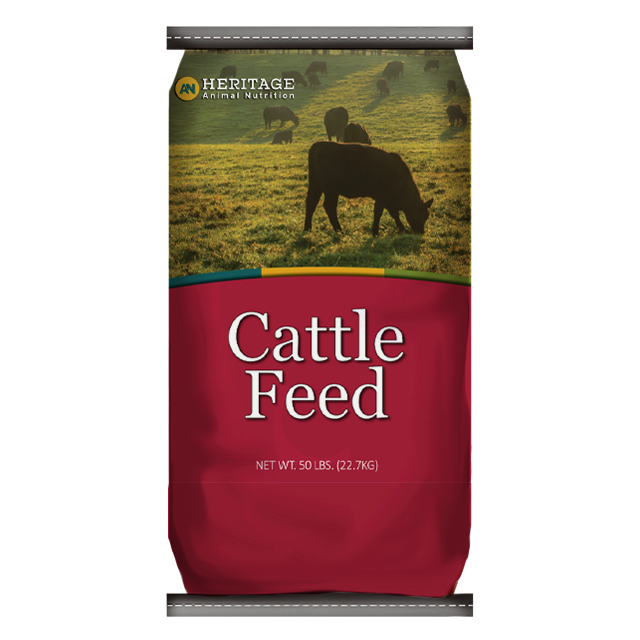
Beef Cattle
Bagged Feed13 Steakmaster R32
TexturedHighly palatable feed designed with high energy for finishing cattle.
- Added yeast to aid in rumen health and nutrient digestion.
- Fully fortified with vitamins and minerals.
- Available in a natural form or with Rumensin to improve feed efficiency and aid in the prevention of coccidiosis
Cattle fed in confinement for slaughter: improved feed efficiency
ACTIVE DRUG INGREDIENT
Monensin ................................. 32 g/ton
Guaranteed Analysis
More >
| Crude Protein | (Min) | 13.0 % |
* This includes not more than 1.2 % equivalent protein from non-protein nitrogen.
| Crude Fat | (Min) | 3.0 % | ||
| Crude Fiber | (Max) | 4.5 % | ||
| Calcium | (Min) | 0.6 | (Max) | 1.1 % |
| Phosphorus | (Min) | 0.4 % | ||
| Salt | (Min) | 0.2 | (Max) | 0.7 % |
| Potassium | (Min) | 0.4 % | ||
| Vitamin A | (Min) | 3,560.0 IU/Lb |
Ingredients
More >
grain products, processed grain by-products, calcium carbonate, urea, salt, plant protein products, soybean oil, molasses products, thiamine mononitrate, magnesium oxide, zinc sulfate, cobalt carbonate, manganese sulfate, ethylenediamine dihydroiodide, vitamin D3 supplement, basic copper chloride, roughage products, sodium selenite, vitamin E supplement, vitamin A supplement, cane molasses, vegetable oil refinery lipid, lecithin, phosphoric acid, propylene glycol. propionic acid (a preservative), sulfuric acid, natural flavors, artificial flavors, kaolin, calcium propionate.
Feeding Directions
More >
Feed 3.13 lbs to 30 lbs to provide 50 to 480 mg/head/day of Monensin to Beef cattle. Provide a good quality forage. Always provide clean, fresh water.
Warning/Caution
More >
WARNING: A withdrawal time has not been established for preruminating calves. Do not use in calves to be processed for veal.
CAUTION: Do not allow horses or other equines access to formulation containing Monensin. Ingestion of Monensin by equines has been fatal. Monensin medicated cattle and goat feed is safe for use in cattle and goats only. Feeding undiluted or mixing errors resulting in high concentrations of Monensin has been fatal to cattle and could be fatal to goats. Must be thoroughly mixed in feeds before use. Do not feed undiluted. Do not exceed the levels of Monensin recommended in the feeding directions as reduced average daily gains may result. If feed refusals containing Monensin are fed to other groups of cattle, the concentration of Monensin in the refusals and amount of refusals fed should be taken into consideration to prevent Monensin overdosing.
LIMITATIONS: Feed only to cattle being fed in confinement for slaughter. Feed continuously in complete feed at a rate of 50 to 480 milligrams of Monensin per head per day. No additional improvement in feed efficiency has been shown from feeding Monensin at levels greater than 30 grams per ton (360 milligrams per head per day).
This feed contains non protein nitrogen.
CAUTION: Do not allow horses or other equines access to formulation containing Monensin. Ingestion of Monensin by equines has been fatal. Monensin medicated cattle and goat feed is safe for use in cattle and goats only. Feeding undiluted or mixing errors resulting in high concentrations of Monensin has been fatal to cattle and could be fatal to goats. Must be thoroughly mixed in feeds before use. Do not feed undiluted. Do not exceed the levels of Monensin recommended in the feeding directions as reduced average daily gains may result. If feed refusals containing Monensin are fed to other groups of cattle, the concentration of Monensin in the refusals and amount of refusals fed should be taken into consideration to prevent Monensin overdosing.
LIMITATIONS: Feed only to cattle being fed in confinement for slaughter. Feed continuously in complete feed at a rate of 50 to 480 milligrams of Monensin per head per day. No additional improvement in feed efficiency has been shown from feeding Monensin at levels greater than 30 grams per ton (360 milligrams per head per day).
This feed contains non protein nitrogen.